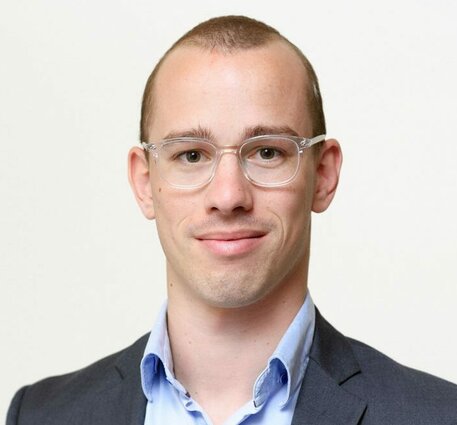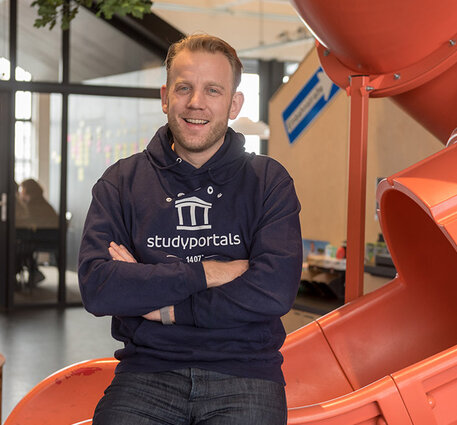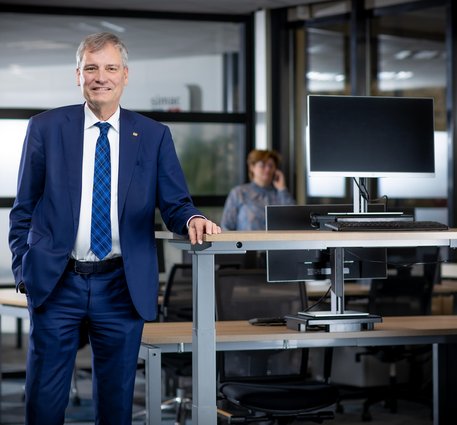
In 2023, we covered hydrogen production in this article . This potential substitute for natural gas is produced using an electrolyzer: a bulky device that splits water molecules into oxygen and hydrogen. This process is called electrolysis and was already used on an industrial scale more than a century ago.
Three steps forward
But the electrolyzer has barely evolved in all that time because we don't know exactly how the device works. Thijs de Groot, associate professor in the field of electrochemical process technology, and his team are finding out. Because only when you know how something works can you start improving on it. And with increasing geopolitical tensions, rising gas prices and the challenging energy transition, that is not a luxury.
We spoke to Thijs and asked about progress. He gave us no less than 3 major steps forward. And we are happy to share them with you.
Step 1) Limiting the transfer of gas
As mentioned, electrolysis is - very simply put - the splitting of water molecules into oxygen and hydrogen by using electricity. The exact operation requires too much explanation, but this progression is about keeping the created oxygen and hydrogen apart with a membrane. The problem is that in most contemporary electrolyzers, too much hydrogen leaks through the membrane. This is particularly problematic when the electrolyzer is running at low speed, as an explosive mixture of oxygen and hydrogen can form.
Thijs: "We know how to reduce that transfer. And that's going to make the electrolyser much more flexible."
Case study: China
This problem is currently being experienced at the Kuqa project in China. Dozens of electrolyzers totalling 260 megawatts were commissioned there last year, making it the largest plant in the world. The electricity the plant needs comes from a park of solar panels that should generate 300 megawatts. But the solar supply varies and that is a problem for the electrolyzers.
However, the plant now runs at only 20%, because too much hydrogen gets into the oxygen. Thijs: "Because the electrolyzers are not flexible enough, the Chinese have no other option but to adjust their operational strategy and turn the electrolyzers off and on frequently. This is not an easy task because the electrodes in electrolyzers do not cope well if you turn them on and off too often. That causes wear and tear."
Thijs: "It amazed me that the electrolyser manufacturers promised that leakage would not be a problem. After all, it's a well-known phenomenon. But you have to hand it to the Chinese: building such a huge factory, they just do it. And I expect they will solve the current problems as well."
Claim 2) A pinch of iron salt
As Thijs himself says "Chemistry is like cooking. Sometimes you try something, you add something, and it works. Or not." In this case, it works. Adding a small amount of iron salt makes the system more efficient, because the iron precipitates on the electrode and facilitates the formation of the oxygen there....
This development raises new questions on which Thijs will focus. Thijs: "Now, of course, we want to know exactly what the optimal amount of iron salt is and what other substances increase efficiency."
Claim 3) lowering the Ohmic resistance
As in all processes involving electricity, resistance plays an important role in electrolysis. The key is to keep that resistance as low as possible. The less resistance, the more efficient the process is. Thijs: "We thought that this Ohmic resistance would have a lower limit. But we can lower it further than we thought."
This is due to an important 'windfall': the bubbles created during electrolysis turn out to have less impact on efficiency than thought. Thijs: "They have some influence, but not very much. This is quite surprising, because there are a lot of bubbles in electrolyzers, but in a well-designed electrolyzer, their influence is therefore minor. "
Testing and scaling up
In all basic research, demonstrating theory is just the beginning. Thijs: "Now we will further test our findings in the laboratory and then scale them up in collaboration with companies. Innovation takes time. On average, it takes about five years before you can successfully apply something that works in the lab in practice. We work together with companies like VDL and with various foreign projects. That helps to work towards a result that companies will actually use and sell.
So much for this update. As soon as there are developments on Thijs' electrolyzer project again, we will of course report back on it.
The original 2023 article can be found here: https://ufe.tue.nl/en/energy/the-electrolyzer.


